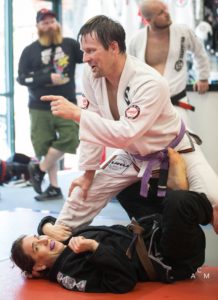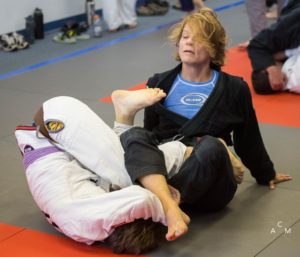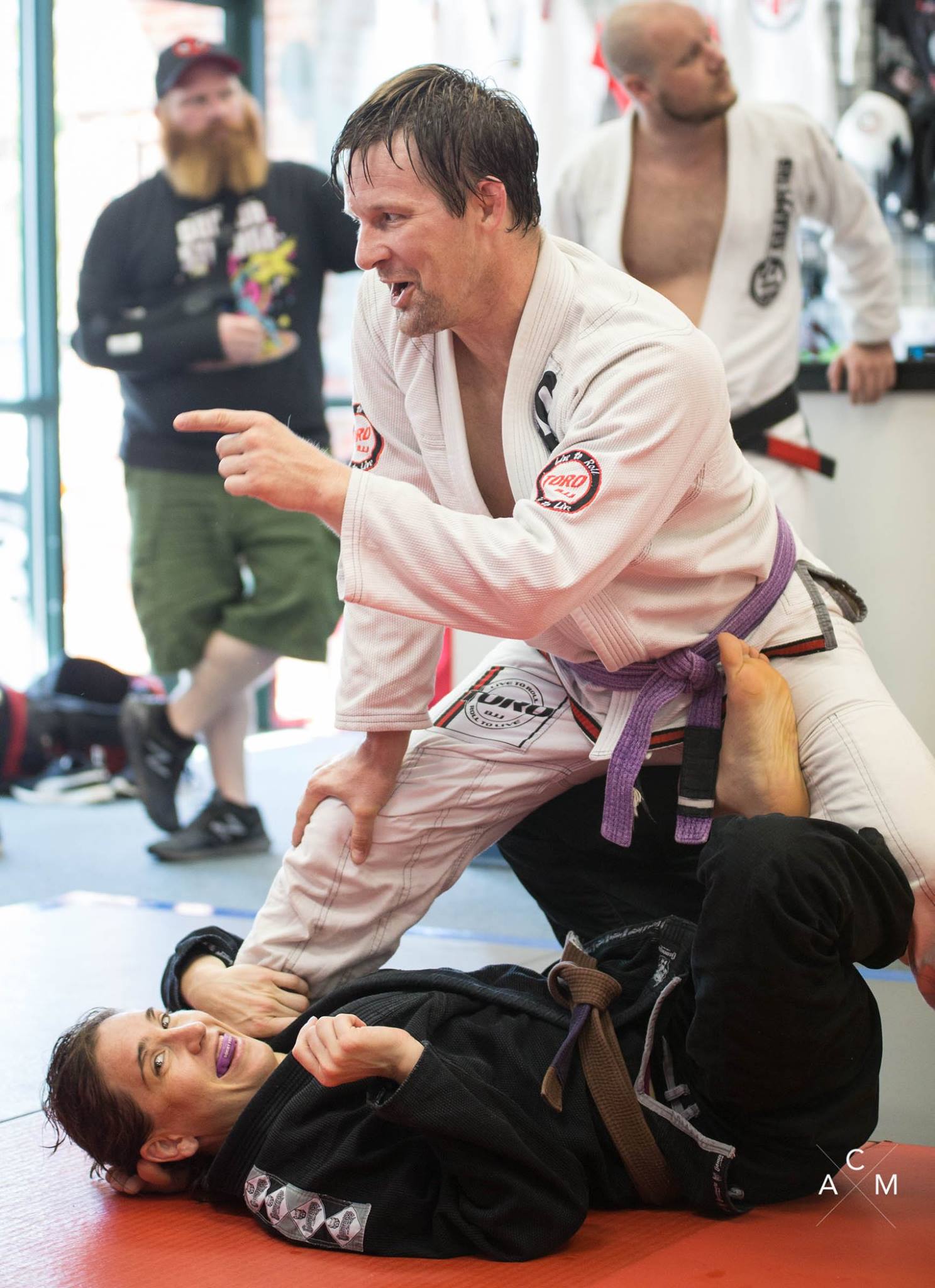It is unrealistic to say there are no potential challenges related to people of different genders training together. That being said, jiu-jitsu is about training—troubleshooting, brainstorming, learning—with people. For that reason, this article is a set of suggestions for anyone who claims a gender identity who has just started training or who is thinking of starting to train.
If we are willing, we can all learn more about how to become great training partners and how to support others in doing the same, no matter our gender identification. Some of this involves respecting differences between men and women and, increasingly, people who eschew a male-female dichotomy. I also believe a lion’s share of the answer is about individual commitment to consideration and self-awareness. These are simple fixes. But simple does not necessarily mean easy.
So, if you claim a gender identity, read on for suggestions about how to contribute to a positive training environment, especially if you are new to jiu-jitsu.

Trust, and then verify, that everyone means well. In jiu-jitsu, the goal is to threaten bodily harm toward your partner without actually inflicting it. This can be a real paradigm shift, and sometimes what is considered normal behavior in a training session can seem like an affront to new participants’ personal safety. For instance, it is not often the case in polite society that another person tries to break your arm. This can inspire strong emotions and self-preservation, particularly given gender differences. And yet, within reason, your training partners are contributing to your development as a grappler precisely by doing what arouses these reactions in you. Talk your perceptions through with your instructor and others you trust to identify the optimal comfort zone you need to start with so you can push yourself beyond it.
Exercise your options. Back in the day, lower belts were seen and not heard, and oftentimes upper belts used them as cannon fodder. They were expected to suck it up and train with anyone who asked, to prove their toughness and remind them of their dispensability. Nowadays, however, it is more common for BJJ students to have a voice in creating their own best training situations, which requires certain actions on our part. Specifically, we want to commit to learning the social norms of this new environment, and within that structure, learn to articulate what is and is not okay for us. For instance, do you feel more comfortable starting in a particular position or NOT in a particular position? Are you okay with a size disparity between you and your partner, or do you want someone close to your stature? Start to recognize those training partners who can provide what you need and who can challenge you. You may be surprised to discover who your go-to training partners become, so be open to people of all shapes, sizes, AND genders.

Recognize there are two people in any training interaction and that both have the right to their preferences. Sometimes we complain about the way our training partners roll with us—too aggressively, too gently, etc. Even if we have a point, let’s review Item 1 and gather more information before drawing conclusions. Is my partner rolling “like a limp rag?” Well, if he is a 250-pound man and I am a 150-pound woman, that does not necessarily mean he is being disrespectful. Perhaps he was raised to be gentle, particularly with women, and translating that into a training situation will take time. Is my partner “going apeshit?” Well, it could be that she was physically assaulted in the past and is trying to maintain control in the way that comes most instinctively to her. You do not have to take on others’ expectations or “fix” their situations. But if you can collect some data, you might be able to develop a good relationship with a “difficult” partner instead of deciding you must discard it completely.
Start slowly. It is common for the upper belt in a training pair to match the intensity of the lower belt in the pair. So, if you are the lower belt and find yourself going 100 miles an hour, consider that your partner might be practicing self-preservation by matching your intensity, and that if you slow it down, your partner will likely do the same. Remember that with the exception of competition and competition preparation, it is never a bad idea to start off slowly. You can always ramp it up at your discretion, but you may not always be able to tone it down in the same way. This is a particularly salient point when it comes to training with someone of a different gender. When you are finished with a round, are you gasping for breath and as tense as a stretched rubber band? If so, you might want to take a few deep breaths and relax your muscles. Remember that learning what is and is not effective and appropriate takes time and practice, so keep at it.
If you are uncomfortable rolling with someone at a different place on the gender continuum, know your rationale. Some people have misgivings about training with members of the opposite sex, perhaps due to religious beliefs. Others believe women should not be training at all. We do not have to be in perfect agreement about these things; there is room for different beliefs as long as no one person’s rights trump another person’s. Am I respectful of others’ right to train even if I do not intend to train with them? I may not want to train with men myself, but that does not give me the right to disparage or question men’s right to train at my school. And if there is any wiggle room in your perspective, consider being willing to broaden it.
Be prepared to learn, all the time, from anyone and everyone. At the beginning of your jiu-jitsu journey, embrace that you are 100% learner and 0% teacher, with the proportion changing virtually imperceptibly over many months and years. In other words, if you are talking, you will be less effective at listening, internalizing, and improving.
To my know-it-all types: You may not agree with the concept of “mansplaining,” but I suspect you have been given unsolicited advice. I further suspect you did not like it. So, men, tread lightly when you consider giving advice to a female training partner, especially if she has been training longer than you. If you insist on talking a woman through a submission she is getting just fine without your help, ask yourself whose needs are really being met: hers or yours. Ladies, we do not get to sit back and feel smug about this one. We can be just as guilty of perpetuating Unwanted Advice Syndrome, so demand appropriate behavior from yourself.
Everyone, if reading this annoys you, ask yourself why. If it is because you feel you are being unfairly maligned, you will not have a problem being quiet and focusing on learning, as that will prove your point. If it is because you feel you already know a lot and it is your responsibility to tell others everything you know, allow me to refer you to a little light reading.
Before you do or say it, ask yourself whether you would do or say it to anyone, regardless of gender identification. Would you be okay with it being said or done to someone you love? During my jiu-jitsu career, I have used the workplace as a model for appropriate social interactions. A jiu-jitsu gym can feel very intimate and is a sanctuary from external stressors for many people. However, we are still getting in each other’s physical space and trusting each other to care more about each other’s safety than about our egos. In this context, it has been my experience that it is better to err on the side of formality than to risk a joke that might fall flat, or worse. Dropping the F-bomb or making comments with racial or gender undertones is not a great idea, no matter how funny and harmless we think we are. Particularly when we are starting out, and particularly when interacting with people whose gender identification differs from ours, consider keeping your interactions with others polite, even if others take different liberties.
Contribute positive energy. I recognize this suggestion is dangerously akin to telling someone to smile, and believe me when I say I am not a fan when strangers say it to me on the street. If those strangers are uncomfortable with my intensity, energy, or demeanor, then that is on them. That being said, when it comes to jiu-jitsu, energy is everything. While rolling, we communicate volumes—our fears, judgments, biases—without saying a word. This means that if we are feeling negative, that negativity is palpable to others. So, while I would never presume to tell anyone to smile, I do encourage all of us to gauge our own energy and recognize the benefit in skewing it positive. It could help you relax, put you in more of a flow state for learning, and develop better relationships with all the students in your school, regardless of gender.

Trust and verify good will. Exercise your options. Recognize the validity of a partner’s expectations and needs. Start slowly and check your reaction to training with others who are not exactly like you. Be open to learning from others, and be open to learning above all else. Check your social interactions with other students, and recognize the benefits of contributing positive energy. Thee are all things we can do to become valued members of our jiu-jitsu academies, regardless of gender.
What are some other ways people, regardless of gender, can acclimate to a training environment? Post your ideas to comments.
Valerie Worthington is a second-degree black belt in BJJ, a certified life coach, and co-founder and proprietor of Groundswell Grappling Concepts. Most recently, Valerie is the author of How to Love a Grappler: A Guide for People Who Love People Who Love Brazilian Jiu-Jitsu. She can be reached through her email.
This is the seventh post in a series called the White Belt Starter Kit, advice for newer students. This series will answer some of the most common questions you might have, like how to get the most out of drilling, how to roll safely and well, how to maximize your training benefits, and how to be a helpful and valuable training partner. There will be a dozen or so posts in the series, which will be available here and updated consistently.
Want to join us on the mat? We’re offering an 8 Week Intro to BJJ class for just $150, and the first 25 registrants will receive a FREE Toro BJJ gi that retails for $155 as part of your registration. You can find the tentative curriculum for the eight-week class here. You can sign up for the Intro to BJJ class here, or you can e-mail jeff@bellinghambjj.com. The first class begins on WEDNESDAY, AUG. 8 from 5:30 p.m.-7 p.m. and runs Mondays, Wednesdays and Fridays following that from Aug. 8 to Sep. 26 at 5:30 p.m. Classes take place at Bellingham MMA, 2694 Roeder, Suite 101, Bellingham, WA, 98225. The last class will be Sep. 26 at 5:30 p.m.

